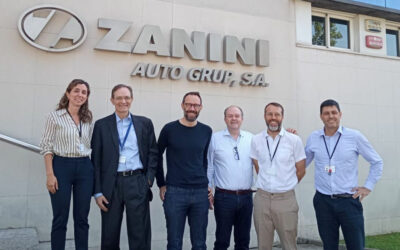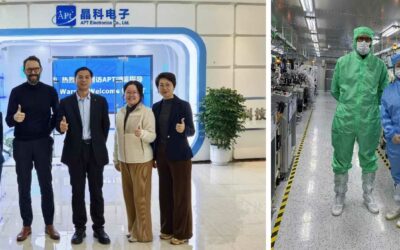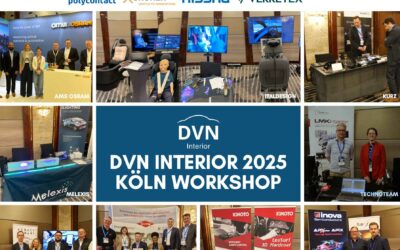Special to DVN Interior by Andy Travers, CEO of Ceres Holographics
There has been a continuous and relentless push to ‘techify’ most of the new vehicles we can purchase and drive. While already populated with more electronics and software than ever for control and monitoring functions, automakers are also increasingly designing them to operate and feel more like the other consumer devices in our lives that we have gotten used to.
Consumers are, somewhat presumptuously, assumed to be enticed by ever bigger and brighter in-cabin displays, multi-function touchscreen controls, and now increasingly ‘AI’-enabled assistants for the ultimate personalization of the driving experience. It is assumed that these enhancements—delivered through an onslaught of visual elements—will make the journey more enjoyable, interactive, and informative. We seemingly want the ultimate personal device or home entertainment experience while driving around town or to our far-off destinations.
However, it seems that beyond the basic transport function of a vehicle, the ability to choose the right combination of these visual elements and to design, develop, and quickly implement them in production cars will define the winners and losers in the automotive industry. Indeed, a recent article in The Economist points out that the biggest innovations in the Chinese car industry are not coming from the traditional automakers, but from consumer electronics giants like Huawei and Xiaomi who, as mobile telecom giants, are applying their expertise in developing absorbing user experiences for phones to the displays and interfaces of a new generation of teched-up cars.
The article recounts an anecdote of a new EV which allowed the driver to play a video game, maneuvering a virtual car on the dashboard display, while at the wheel of the actual car.
UX is the new horsepower
While that’s an extreme scenario of today’s multitasking drivers, it points out important trends at work as automakers battle to differentiate and paint a futuristic vision of what we will experience while we move about during our day-to-day lives, particularly with consumers in the smartphone generations.
The shift to include those types of features and technologies is well underway as car buyers’ purchasing decisions are now based more on what’s on the dashboard (and often specifically its ability to work with their mobile device) than what’s under the hood in terms of horsepower and fuel consumption.
The thinking that has evolved is that nothing will wow a tech consumer—whether they’re shopping for living room entertainment, a smartphone, a computer, or their next set of wheels—more than an oversized brilliant display, made even more appealing by touch (or touchless!) control.
Much of this, of course, was driven by the promise of a rapid transition to full autonomous driving, with carmakers leaping ahead to re-imagine the entire in-vehicle place and experience and create ways to keep occupants entertained when they are less concerned about driving the car (if they’re even required to drive it).
But the AV dream is not panning out quite as originally envisioned, or as fast. Safety and practicality concerns continue to present obstacles yet to be satisfactorily met. Cooler heads are prevailing, both in industry and in governments, and now there is a more specific and immediate focus on driver assistance technology, not driver replacement. Importantly, top-brand automakers are realizing that the most valuable and loyal customers are those who enjoy the driving experience itself, and not the ones looking for a car that can drive itself.
On top of that, industry surveys indicate that consumers are overwhelmed and increasingly frustrated by the amount and complexity of tech populating their cabins. Case in point from a recent review of major European luxury vehicle: “Unfortunately, [the infotainment system] is (…) generally overcomplicated and anti-intuitive”.

Wow factor at the cost of safety?
All of this brings us to the critical point: As much as we’d like these sensor-laden (and sensory-overloading) cars to function like our phones and laptops, we must never forget that the primary objective of today’s vehicles is still to get us from point A to Point B safely, and perhaps as a welcome secondary bonus, comfortably and enjoyably!
Unlike our closely-held mobile devices, we don’t—we can’t—drive or operate a car in a distraction-free or hazard-free vacuum, oblivious to the uncontrolled and random interruptions that road travel presents and that do require our relentless attention.
This can include other drivers of high-tech vehicles, often focused on things other than driving (not to mention the pedestrian immersed in a social media doomscroll as they meander across a busy street). Or at the other end of the spectrum, a barely-roadworthy farm vehicle is allowed you to join on the road, though it is not fitted with the latest anti-collision or driver-assist technology.
But in our quest to smartphone-ize the car, we may have been distracted from the fundamental need for safety first. In order to refocus on this priority, there needs to be a rethinking of how consumer electronics-inspired technology and display interfaces can and should work in a car.
The always insightful publication Driving Vision News underscores the point in a recent article on HMI: “… unlike consumer devices, car [display] interfaces must prioritize safety, ensuring minimal distraction from driving and allowing operation of the car without unnecessary or excessive cognitive load”. It goes on to note that consumer devices and their apps are designed to grab and captivate the users’ attention and cognition: “Screens in cars should have the exact opposite effect: as little distraction and cognitive load as possible. The eyes and mind should stay on the road, not on the screen”.
Distracted driving remains the top cause of accidents and road fatalities, so it’s no surprise that regulators are paying close attention to this smartphone-ization trend. For example, a recent push by insurance companies and road safety organizations such as NCAP is advocating for the reduction or removal of touchscreen-driven control mechanisms that require visual interaction (such as swiping though a touch menu) and a reversion to more tactile knobs and switches that enable drivers to make whatever adjustment or operate whatever control without taking their attention off the road.
Old-school control methods, while less flashy and cool, actually work better when it comes to safety. A recent study comparing speed, accuracy, and distraction in operating the controls of a 2005 car versus modern cars showed that physical controls are much safer and less distracting than complex touchscreens.
BMW CEO Oliver Zipse controversially went one step further, saying said he is “absolutely convinced” that the large center-console-based screens and touchscreens will soon disappear through legislation.
Don’t stop the tech push
None of this is meant to imply that new technology can’t be a huge benefit to young or experienced carmakers, drivers and passengers. A multitude of innovations in computer vision, sensing, electrification, and HMI technology have already made driving safer, more efficient, and more enjoyable, and that will continue. The pace of change, driven partly by the emergence of new, more tech savvy entrants, has bolstered the entire industry.
Well established top-brand automakers from the USA and Europe now realize that they must embrace the optimal technology in unprecedented ways, partly as a result of checking their own rearview mirrors and realizing that their competition is pressing them from a multitude of on-ramps, from Beijing to Bangalore.
The blisteringly rapid pace at which Chinese and Indian manufacturers are moving new vehicle concepts from the drawing board to production is startling to the long-established western automakers. They cannot afford to stand still and ignore the tsunami of customer desire.
Ceres Transparent HUDs

At Ceres we have a front row seat, literally, to the changes happening in the cockpits of cars and trucks of the future. Interest in our transparent head-up display (HUD) technology—originally inspired by jet fighter navigation systems (the ultimate in non-distractive use cases)—has spiked in recent years as automakers look for ways to improve the user experience without compromising on safety. A bright, crisp, clear HUD in a vehicle with well-designed HMI content, and comfortable tactile controls on the steering wheel, delivers optimal information and action requests to the driver while maintaining crucial eyes-on-road behavior.
Head up, eyes ahead
HUDs have a bit of fraught history in automotive, struggling to overcome challenges related to cost, display performance, package size, ease of implementation and scalability. Holographic displays have long been seen as a potential solution for those issues by automakers, as far back as the 1980’s.
But our advances in the design and production of holographic optical elements (HOEs) and industrialized manufacturing capability, along with a viable windshield supply chain emerging, have taken down the barriers.
Serious evaluation of our holographic enabled HUDs is happening at most top automakers as a viable transformational technology that can keep eyes and attention on task, and drivers driving safely and comfortably. HUDs are earning favor over the physical console displays that require a driver to look downward and sideways to view and then process operational information.

We are greatly encouraged by the progress being made by automakers who see the value of new (and cool!) safety-oriented interfaces to their vehicles. A recent presentation from Ford at the SID2024 automotive display conference (reported in DVN Interior) about their development, test, and approval of manufactured HOE-enabled HUD windshields, underscored the benefits and practicality of embedding display technology in windshields. They concluded, after significant user testing at their comprehensive design clinics, that such systems can offer drivers a seamless and non-distracting way to view information and take actions without losing focus on the road ahead.
At some point in the future, driverless cars may whisk us around, freeing us to watch movies, check email, and play video games—all which can also be enabled by HUD technology that takes advantage of the bountiful glass real estate available in vehicles, a more cost-effective approach than multiple LED displays. But for now, and the foreseeable future, safe operation by human drivers must remain a top priority, together with an enjoyable connected experience.






